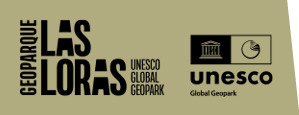THE BLIND VALLEY GEOTRAIL
“El Valle Ciego”
“The Blind Valley”
Blind valley refers to those valleys where a river disappears through a sink. In this case, only less than one mile away from Basconcillos del Tozo, the Hurón River enters the Cueva del Agua Cave and disappears, under the limestone rocky massif. The water running underground causes the dissolution of carbonate material and forms a one mile height gallery, where collapses, which can be observed in the shape of dolines on the surface, have been produced. Such are the examples of Cueva del Agua Cave, Las Ánimas doline, next to the chapel of the same name, and Los Caracoles doline.
“El Valle Ciego”
Once the river comes out of the cave it becomes to be called Rudrón. It flows out from Cueva de los Moros Cave up to Barrio Panizares vicinity, exposing the effects of erosion on the steep slopes of the canyon.
On the whole, the Blind Valley is a system where the formation of a canyon on a limestone massif can be observed in real time in the very heart of Las Loras.
The catalogue of formations that can be observed from the geotrail illustrates the impressive sequence of processes generating a canyon: blind valley, collapse dolines, natural bridges (Puente del Diablo Bridge), slopes covered with active screes, slope detachments and slipped rock masses. They all concentrate in this small area of the Geopark, offering a graphic example of how the other big canyons found at the Geopark were formed.
Myths and legends*
In the mid-nineteenth century, Pascual Madoz in his well known “Geographical, Statistical and Historical Dictionary” tell us about some rocks that since time immemorial had been known as Patada del Cid (Cid’s Kick) and in which the footprints of a fantastic man and the tracks of his outstanding horse are engraved.
People also mention a legend telling how a giant snake that was hiding in a cave, swallowed seven children up and then came out from a big stone arch engraved on the rock mountain and went to the Rudrón River in order to drink its water. When El Cid found out about this terrible event, he rode to that site and killed the monster.
Wall paintings from the fifteenth century, showing an evil dragon swallowing several souls can be contemplated inside the Romanesque church of Basconcillos del Tozo. Maybe the famous legend of Cueva del Agua Cave serpent and the chapel dedicated to the Souls, only some metres away from the first, are based on this tremendous religious representation.
*Fourth Volume of “Unique spots in Burgos”, Enrique del Rivero, released by Caja Burgos. 2000
